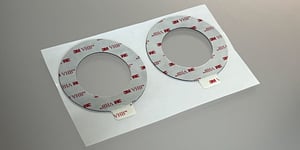Have you ever paid for a service and thought, “Huh, I wonder if this IS the typical cost.”
Getting a quote without a frame of reference is like stumbling around in the dark. Even if a converter issued you a reasonable offer, would you be able to recognize it?
As a flexible material converter that produces custom parts, Strouse issues daily custom project quotes. We’re constantly calculating the cost of custom gasket cutting for our clients, so today, we hope to provide you insight into its pricing.
When you know the factors determining the price of custom die cut gaskets, you can better prepare yourself to receive your quote and understand where the different costs are coming from once they’re all broken down.
How Much is Custom Gasket Cutting?
Let’s start with a hypothetical quote:
If your gasket uses foam (which many gaskets do), it’s very possible your converter cannot cut it with a laser. They will need to purchase a die cut tool, which costs anywhere between $500 and $80,000 depending on the quality needed, the scale of your project, the complexity of your design, and the tolerances you’ve specified.
You’re probably thinking, “Wait! That’s such an insane difference in price, how am I supposed to factor this into my final budget?”
This is where gasket function comes into play: a simple geometrical design won’t cost you eighty grand in die cut tooling, but a design with insanely tight tolerances, which requires high-quality tooling because it looks like the back of a cross stitch, is destined for a costly tool.
What Determines the Price of a Custom Die Cut Gasket?
There’s a massive difference between cutting out a circle and attempting to use a rotary die to recreate the Mona Lisa.
The price of your custom gasket is affected by its intended function, materials, design, size, and tolerances. The more complex any of these factors are, the more difficult it is to process, which increases the cost.
We’re going to take a closer look at each of these factors and analyze how they are able to increase the overall cost through additional labor time and materials.
1. THE FUNCTION OF THE GASKET
The ultimate goal of building a gasket is to ensure it functions correctly, so the function of your custom gasket has a massive effect on all the other aspects of its cost.
Gaskets come in all different shapes and sizes, but certain gaskets are far more intricate than your typical circular part of general foam designed to trap air. However, complex designs are more challenging to produce because they might require tight tolerance tools or slower run times, both of which lead to more expensive products.
Another aspect of gasket functionality is the price of its material and whether it’s easy to work with or could cause costly setup waste.
2. DIFFERENT GASKET MATERIALS
A gasket’s purpose is to seal substrates together and reduce the probability of leakage, but the cost of your gasket will vary significantly based on what you want to seal.
- Material costs comprise 70-80% of the total costs, and gasket materials range from general-purpose foam to less cheap, highly specialized materials.
For instance, converters often use open-cell foam to build more flexible and shock-resistant gaskets, while closed-cell foam is used for outdoor and liquid sealing applications. The closed-cell foam tends to be more expensive than open-cell foam, which means gaskets that seal against moisture could cost more, the same as any other specialized materials.
3. DIE CUT GASKET SIZE
Gaskets are rings or other shapes with holes in the middle cut out from rolled or sheeted material. Unfortunately, when you cut out a gasket, you’re wasting the material in the center:
Larger gaskets, or gaskets with a larger diameter, result in more wasted material due to the shape’s design. On a rotary die cut press, the leftover material in the middle is peeled away from the liner and discarded.
Whether you’ve accepted the cost of the wasted material or are still looking into alternate solutions, you can see why larger gaskets cost more not just because of the material the gasket itself consumes but also because of the excess material lost in the middle.
NESTING AND SEGMENTED GASKETS
Certain companies use methods such as nesting parts to create gaskets with less of a waste factor.
- Nesting parts refer to separate pieces cut to make up the object of the design rather than cutting out the design itself.
For instance, you would create a square gasket by cutting out four perpendicular pieces rather than slicing the final piece directly from the material into one solid part. These gaskets, assembled using individually cut pieces, are also called segmented gaskets.
However, the one concern with using nesting parts to construct segmented gaskets is that the corners are more likely to fail because they’ve been joined later in the process.
4. GASKETING DESIGN TOLERANCES
Design tolerances refer to the amount your measurements can vary before the part is considered defective.
Tighter tolerances are more challenging to adhere to on a machine press, and it becomes more difficult to cut foam as the foam gets thicker. The thicker your material and the tighter your tolerances are, the more complicated and more expensive it will be to run your part successfully.
4. CUSTOM GASKET PRODUCTION COST
Producing a custom part involves many labor costs, such as set-up, breakdown, and machine run time.
With custom gaskets, each converter who runs a design on their rotary die cut machines for the first time will need to make the initial adjustments to ensure it runs properly.
This set-up period could take a handful of hours to days spent making adjustments and trying out different ways of running the machine press to maximize its part accuracy before running a greater quantity.
Generally speaking, you’ll pay a more favorable percentage when you order in bulk than somebody who orders the minimum quantity of die cut parts due to fixed costs.
Should I Buy Custom Die Cut Gaskets?
If you haven’t found pre-existing gaskets on the market that could serve your application, custom gaskets are a promising option.
Now that you know the factors that determine the cost of a gasket, you’ll better understand how much it’ll cost to build your design.
But even knowing your gasket’s size, material, and application, you still might not know how much you’ll pay for partial tooling or your converter’s labor time costs.
We can’t speak for every converter, but if you want to test the waters with us, Strouse would be glad to give you a custom gasket quote and talk more about your application process.
Originally published: April 4, 2023







